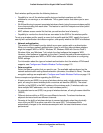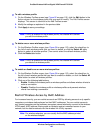
Wireless Configuration and Security
113
ProSafe Wireless-N 8-Port Gigabit VPN Firewall FVS318N
Each wireless profile provides the following features:
• Cap
ability to turn off the wireless profile during scheduled vacations and office
shutdowns, on evenings, or on weekends. This a green feature that allows you to save
energy.
• W
LAN partitioning to prevent associated wireless clients (using the same wireless profile)
from communicating with each other. This feature is useful for hotspots and other public
access situations.
• MAC address a
ccess control list that lets you add another level of security.
• Cap
ability to monitor the clients that are connected to the SSID of the wireless profile.
To set up a wireless profile, specify a name for th
e profile and the SSID, specify the type of
security with authentication and data encryption, and specify whether the SSID is broadcast.
• Network auth
entication
The wireless VPN firewall is set by default as
an open system with no authentication.
When you configure network authentication, bear in mind that older wireless adapters
might not support WPA or WPA2. Windows XP, Windows 2000 with Service Pack 3,
Windows Vista, and Windows 7 do include the client software that supports WPA.
However, client software is required on the client. Consult the product documentation for
your wireless adapter and WPA or WPA2 client software for instructions on configuring
WPA2 settings.
For information about the types of network authe
ntication that the wireless VPN firewall
supports, see Configure and Enable Wireless Profiles o
n page 115.
• Dat
a encryption
Select the data encryption that you want to use. The available options depend on the
n
etwork authentication setting described earlier (otherwise, the default is None). The data
encryption settings are explained in Configure and Enable Wireless Profiles on p
age 115.
Some concepts and guidelines regarding the SSID are:
• A basic service set (BSS) is a group of wireless devices and a single wireless access
p
oint, all using the same wireless profile or service set identifier (BSSID). The actual
identifier in the BSSID is the MAC address of the wireless radio. (A wireless radio can
have multiple MAC addresses, one for each wireless profile.)
• An extended
service set (ESS) is a group of wireless devices, all using the same identifier
(ESSID).
• Dif
ferent devices within an ESS can use different channels. To reduce interference,
adjacent devices should use different channels.
• Roa
ming is the ability of wireless devices to connect wirelessly when they physically
move from one BSS to another one within the same ESS. The wireless device
automatically changes to the wireless access point with the least interference or best
performance.


















